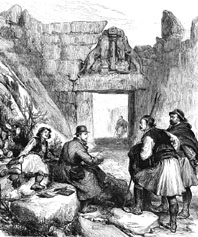

 | Page 1151 |  |
the small Turkish village believed to be the site of Homer’s Troy. Although he found many antiquities and architectural features, it took two years and a deep trench to get to the bottom of the site and find what he considered to be a wall of the Trojan city. The next year he unearthed what he claimed to be “Priam’s hoard” (a collection of artifacts supposedly belonging to the King of Troy during the Trojan War). It is clear that the material was assembled over time and from several different sites to resemble a Trojan treasure, which he then smuggled out of Turkey and used as proof that he had uncovered Homer’s Troy. He had, in fact, found remains older than Troy, but to get to them he had destroyed some of what he had thought he was looking for.
In 1876, Schliemann began to excavate within the citadel at Mycenae in central greece where he unearthed graves packed with gold comprising more than 100 pounds of artifacts including masks, diadems, goblets and other ornaments, gem-encrusted bronze swords, silver perfume bottles, and painted earthenware vessels. Schliemann believed he had found the graves of Agamemnon and his retinue, but the graves proved to be about three centuries older than the period of the Trojan War. In 1878, Schliemann returned to Hissarlik to correct the errors of the earlier work there with new, more methodical and systematic excavations and to halt criticism by journalists and archaeologists. During this season, the German anthropologist rudolf virchow visited and offered advice to Schliemann and lent credibility to the work.
In 1880, Schliemann moved back to Greece to excavate Orchomenos, where the legendary King Minias and the Minoan people had lived. He hired wilhelm dorpfeld, a young architect and a secretary at the deutsches archäologisches institut (German Archaeological Institute) in Athens, whom he had met years earlier at ernst curtius’s excavations at Olympia. It was the beginning of a collaboration that gave Schliemann the archaeological credibility he needed. Two years later, Schliemann took Dorpfeld to Hissarlik for a third season of excavation there. Dorpfeld quickly sorted out the stratigraphy of the walls and when they had been built and rectified Schliemann’s mistakes; he also discovered a continuation of the city in a valley outside the walls. In 1884, Schliemann began excavating in Greece again, this time at Tiryns, and continued doing so for the next two years to develop a clearer picture of Mycenaean culture.

Schliemann at the excavation of Mycenae
(Ann Ronan Picture Library)
In subsequent years, Schliemann reflected less on the rehabilitation and confirmation of Homer and more on the civilization that came to light through Homer’s epic. In 1883, he defended Dorpfeld and himself from criticism by the amateur archaeologist Ernst Botticher, and in 1889, he rushed to Paris to repeat his defense at the Anthropological Congress held there, which resulted in a large number of archaeologists inspecting the excavations at Hissarlik in 1890 with Schliemann and Dorpfeld as their guides. It would be the last time he would visit the site—he died later that year. All of Athenian high society, including the king of Greece, was present at his burial in Athens.
Schliemann was more treasure hunter than model archaeologist, and he can be accused of many faults—arrogant naiveté, general carelessness, precipitate identifications, wholesale destruction of archaeological material, and fraud—but his contribution to archaeology was
 |  |